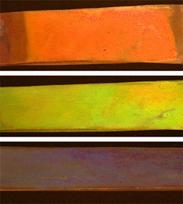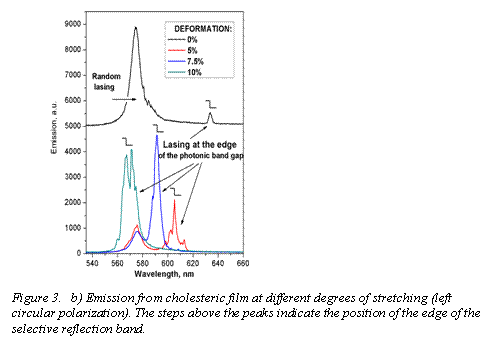
Back to Table of Contents
44107-GB7
New Kinds of Responsive Chiral Materials Based on Cholesteric Liquid Crystal Polymers
Petr V. Shibaev, Fordham University
The
first year of the project was devoted to the design and synthesis of cholesteric
polymers sensitive to pH-changes of aqueous solutions and biological agents.
New
cholesteric materials sensitive to external mechanical fields were designed and
studied during the course of the second year. These polymer materials are
highly viscous and change the spectral position of photonic band gap ( and
color ) under mechanical stress. These materials can also be used as
mechanically tunable lasers.
Color
changing cholesteric materials were prepared by mixing 60-85 wt.% of a
silicone-based cholesteric liquid crystal C4745 or
C4754(Wacker Co) , 40-15 wt.% of a nematic liquid crystal, MBBA
(Sigma-Aldrich Co.) and 0.3-0.5% of laser dye Pyrromethene 597. Wacker
silicones (see Fig.1a) are cyclic polymers that form cholesteric glass when
cooled to room temperature from the melt. By mixing these polymers with nematic
liquid crystal (MBBA, see Fig.1b), it was possible to change the helical pitch
of the cholesteric liquid crystal and adjust the position of the selective
reflection band to


any
point in the spectrum from near IR to violet in the undeformed material.
All
measurements were made at room temperature. With an increasing concentration of
polymer, the viscosity of the cholesteric liquid crystal rapidly increases. For
instance, viscosity of the cholesteric mixture with 80% MBBA is about 0.1Pas;
viscosity of the mixture with c.a. 30% MBBA is c.a. 5*103 Pas. The
cholesteric liquid crystal was placed between two transparent silicone stripes
and 
Fig. 2. Schematic representation of cholesteric helix, its deformation and optically pumped lasing. External force was applied to the silicone stripes that resulted in the contraction of the sample in the direction perpendicular to force. | |
stretching
deformations were applied to the materials placed between two transparent
silicon stripes containing a liquid crystalline mixture (Fig.2). Stretching of
the sandwiched materials induces a shift of the selective reflection band from
a longer wavelength toward a shorter wavelength. The shift is accompanied by
color changes, which depend on the degree of stretching and the composition of
the cholesteric 

|
|  |
liquid
crystal. A film with a composition (75% of Wacker C4745 and 25% of
MBBA )
that results in a color change from red to blue under a deformation of
approximately 25% is shown in Fig. 3a. The color was immediately and completely
restored after deformation.
If
the film is kept stretched, then restoration of the color required six or more
hours.Excitation
of cholesteric films by Nd:YAG laser ( with laser dye Pyrromethene 597 )
results in fluorescence and lasing. The selective reflection band of the
unstretched film was positioned at 640 nm (Fig.3b, upper curve). In the
unstretched, reddish film, two emission peaks were observed in the spectrum of
left-handed circularly polarized light. One peak was a broad emission centered
at 572 nm corresponding to the top of fluorescence band of the pyrromethene
laser dye in this matrix. The peak, at c.a. 640 nm, corresponds to the high
energy edge of the selective reflection band schematically shown as a step in
Fig. 3b (upper part). Under conditions of stretching, the left-circularly
polarized lasing emission from the polymer film shifts towards the blue end of
the visible spectrum following the position of the selective reflection band
(Fig.3b, lower curves). The left-handed emission in stretched film displays a
number of sharp peaks with the intensity increasing at shorter wavelengths
(right-handed emission does not display any sharp peaks). The intensity
increases in the band edge lasing modes positioned close to 572 nm because the
selective reflection band shifts toward the peak of the laser dye emission with
increased quantum efficiency of emission. If there were no amplification of
emission at the edge of the selective reflection band, the emission at 600 nm
would have been smaller than the emission at 572 nm by a factor of c.a. 100. The
research grant from PRF had a profound effect on the scientific career of P. I.
During the course of the project 5 articles co-authorized with the students
were published in scientific journals and two presentations were made at
scientific conferences. This grant allowed not only to conduct scientific
research by P.I., but also supported research projects of 6 students. This, in
turn, had an important educational impact and helped students to secure good
jobs. Finally, this grant helped P.I. to get a tenured position at Fordham University.
Back to top







